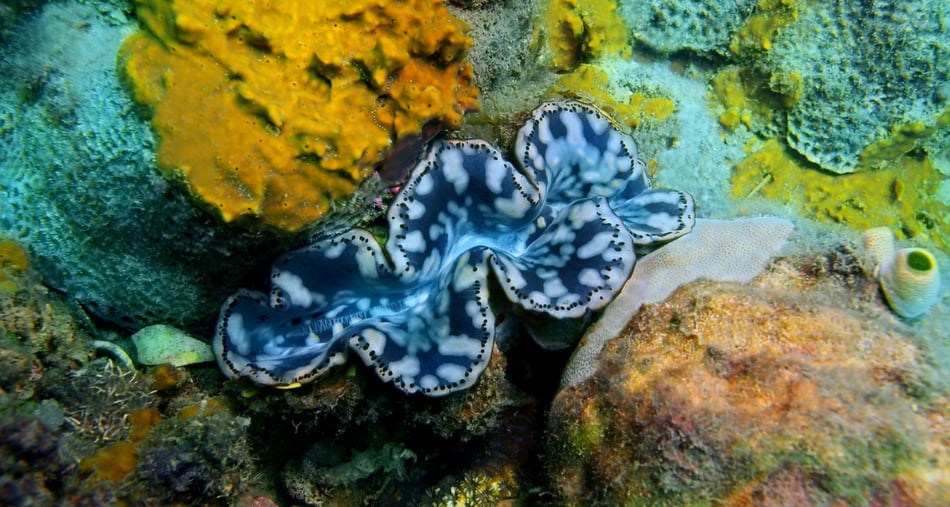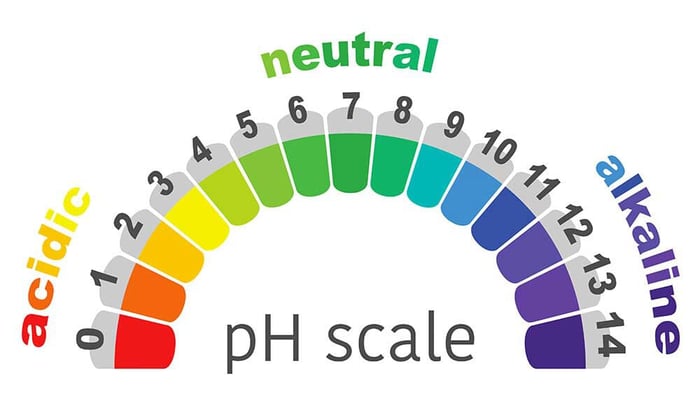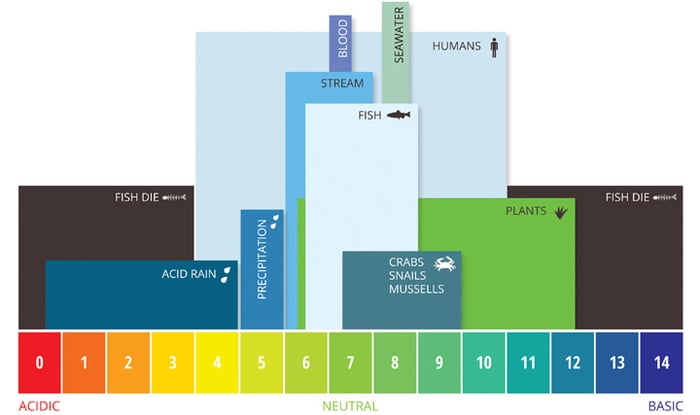The importance of pH for dissolved CO2 uptake - why this matters for giant clams

Jordan
4
min. read

What is pH?
pH is a crucial parameter in various scientific fields, including chemistry, biology, and environmental science. It is a measure of the hydrogen ion concentration in a solution, which determines the solution's acidity or alkalinity. The pH scale ranges from 0 to 14, with 7 being neutral. Values below 7 indicate acidity, while values above 7 indicate alkalinity. Understanding and controlling pH levels are essential in numerous applications, from industrial processes to maintaining ecological balance in natural water bodies.
pH is a crucial parameter in various scientific fields, including chemistry, biology, and environmental science. It is a measure of the hydrogen ion concentration in a solution, which determines the solution's acidity or alkalinity. The pH scale ranges from 0 to 14, with 7 being neutral. Values below 7 indicate acidity, while values above 7 indicate alkalinity. Understanding and controlling pH levels are essential in numerous applications, from industrial processes to maintaining ecological balance in natural water bodies.

Normal vs. altered pH levels
Acidification refers to the process of decreasing pH, resulting in increased acidity. This phenomenon can occur in various environments, such as soil, water bodies, and even within living organisms. In aquatic systems, acidification can have detrimental effects on aquatic life, including fish and other marine organisms, by altering their metabolic and reproductive processes.
Increasing the pH level of a solution or environment indicates a shift towards alkalinity. Higher pH levels can affect chemical reactions and biological processes. For instance, in aquatic environments, higher pH levels can lead to a decreased ability to dissolve carbon dioxide (CO₂), subsequently affecting the formation of carbonate (CO₃²⁻) and bicarbonate (HCO₃⁻) ions. These ions are crucial for the structural integrity of shells and skeletons of marine organisms, such as corals and mollusks.

Methods for increasing pH
Several methods are employed to increase pH levels in various contexts, from aquariums and swimming pools to industrial applications. Each method has its specific advantages and mechanisms of action.
Kalkwasser (Calcium Hydroxide)
Kalkwasser, or limewater, is a solution of calcium hydroxide (Ca(OH)₂). It is commonly used in marine aquariums to increase pH and supplement calcium. When added to water, calcium hydroxide dissociates, releasing hydroxide ions (OH⁻), which increase the pH. Additionally, calcium ions (Ca²⁺) contribute to the formation of calcium carbonate (CaCO₃), beneficial for organisms requiring calcium for skeletal structures.
Baking Soda (Sodium Bicarbonate)
Sodium bicarbonate (NaHCO₃), commonly known as baking soda, is another effective means of raising pH. When dissolved in water, it dissociates into sodium (Na⁺) and bicarbonate ions (HCO₃⁻). The bicarbonate acts as a buffer, neutralizing acids and thereby increasing the pH. This method is often used in freshwater aquariums and industrial processes.
Calcium Carbonate Powders
Calcium carbonate (CaCO₃) powders are used to increase pH in both aquatic and terrestrial environments. When added to water, calcium carbonate slowly dissolves, releasing calcium and carbonate ions. The carbonate ions react with hydrogen ions (H⁺) to form bicarbonate, thereby reducing acidity and increasing pH. This method is frequently used in agriculture to neutralize acidic soils.
Electrolysis
Electrolysis involves using an electric current to induce chemical reactions in a solution. In the context of pH adjustment, electrolysis can generate hydroxide ions at the cathode, thereby increasing the pH of the solution. This method is precise and can be controlled by adjusting the current and duration of the process. It is used in various industrial applications where precise pH control is required.
Sodium Hydroxide
Sodium hydroxide (NaOH), also known as lye or caustic soda, is a strong base commonly used to increase pH. When dissolved in water, it dissociates completely into sodium and hydroxide ions, leading to a significant increase in pH. Due to its high reactivity, sodium hydroxide is used in numerous industrial processes, including water treatment and chemical manufacturing.
Magnesium Hydroxide
Magnesium hydroxide (Mg(OH)₂) is another base used to raise pH levels. It is less soluble in water than sodium hydroxide, providing a more gradual increase in pH. Magnesium hydroxide dissociates into magnesium and hydroxide ions, the latter contributing to the alkalinity of the solution. This method is often employed in wastewater treatment and as an antacid in medicine.

What IMARCS is doing in mariculture tanks
The pH level of a solution is a critical factor influencing chemical reactions and biological processes. Understanding the mechanisms behind pH changes and the methods available for pH adjustment is essential for maintaining optimal conditions in various environments, including mariculture tanks and reef ecosystems. At IMARCS, we are focused on increasing pH levels in our tanks to allow for the increased dissolution and uptake of CO2, which we are studying to assess the viability of increased atmospheric carbon sequestration. With this, several methods of increasing pH are not applicable to the work that we are doing. Electrolysis is not possible with living giant clams in our tanks, and the short-lived effects of this method would not be useful if applied far from these clams in an adjacent tank system or other peripheral application. Utilizing baking soda or calcium carbonate powders would also defeat the purpose of trying to increase the uptake of dissolved atmospheric CO2, as the increased carbon uptake would come directly from the added calcium carbonate.
The three main avenues for increasing pH for the IMARCS Foundation's research are the three hydroxides: magnesium, sodium, and calcium. The latter of these, calcium hydroxide (also referred to as kalkwasser), is currently the preferred method being employed and the first to be studied in our in-shore tank facility. After testing this methodology we will move on to testing sodium hydroxide and magnesium hydroxide for their respective applicability in increasing pH and dissolved CO2 uptake. Magnesium hydroxide in particular is appealing due to the fact that it could be scaled up and applied in larger reef environments to potentially increase atmospheric CO2 uptake in marine environments, if it indeed proves successful in our mariculture tanks. Whichever solution proves to be the most valuable, it will be an important tool in the ongoing effort to find novel, nature-based solutions for sequestering atmospheric carbon dioxide and improving marine ecosystem health.
The three main avenues for increasing pH for the IMARCS Foundation's research are the three hydroxides: magnesium, sodium, and calcium. The latter of these, calcium hydroxide (also referred to as kalkwasser), is currently the preferred method being employed and the first to be studied in our in-shore tank facility. After testing this methodology we will move on to testing sodium hydroxide and magnesium hydroxide for their respective applicability in increasing pH and dissolved CO2 uptake. Magnesium hydroxide in particular is appealing due to the fact that it could be scaled up and applied in larger reef environments to potentially increase atmospheric CO2 uptake in marine environments, if it indeed proves successful in our mariculture tanks. Whichever solution proves to be the most valuable, it will be an important tool in the ongoing effort to find novel, nature-based solutions for sequestering atmospheric carbon dioxide and improving marine ecosystem health.
Further reading:
Caldeira, K., & Wickett, M. E. (2003). Oceanography: Anthropogenic carbon and ocean pH. Nature, 425(6956), 365.
This paper discusses the impact of anthropogenic carbon dioxide emissions on ocean pH levels, providing an in-depth analysis of ocean acidification and its potential consequences for marine life.
Guo, W., Wang, H., & Yang, Z. (2019). Electrochemical pH adjustment and its application in environmental engineering: A review. Journal of Environmental Chemical Engineering, 7(2), 102963.
This review covers various electrochemical methods for pH adjustment, exploring their applications in environmental engineering and wastewater treatment, and discussing the advantages and limitations of these techniques.
Paerl, H. W., Xu, H., & Hall, N. S. (2014). Controlling harmful cyanobacterial blooms in a world experiencing anthropogenic and climatic-induced change. Science of The Total Environment, 506-507, 362-368.
This paper investigates methods for controlling harmful cyanobacterial blooms, emphasizing the importance of pH regulation in aquatic systems and the role of various buffering agents, including sodium bicarbonate.
Riebesell, U., Fabry, V. J., Hansson, L., & Gattuso, J.-P. (2011). Guide to best practices for ocean acidification research and data reporting. Publications Office of the European Union.
This comprehensive guide provides standardized protocols for conducting ocean acidification research, including pH measurement techniques and data reporting standards, essential for researchers studying marine ecosystems.
Zhao, H., & Wang, Y. (2016). Application of magnesium hydroxide in wastewater treatment. Environmental Science and Pollution Research, 23(3), 2534-2542.
This article explores the use of magnesium hydroxide in wastewater treatment processes, detailing its effectiveness in pH adjustment and its advantages over other chemical methods in various industrial applications.
This paper discusses the impact of anthropogenic carbon dioxide emissions on ocean pH levels, providing an in-depth analysis of ocean acidification and its potential consequences for marine life.
Guo, W., Wang, H., & Yang, Z. (2019). Electrochemical pH adjustment and its application in environmental engineering: A review. Journal of Environmental Chemical Engineering, 7(2), 102963.
This review covers various electrochemical methods for pH adjustment, exploring their applications in environmental engineering and wastewater treatment, and discussing the advantages and limitations of these techniques.
Paerl, H. W., Xu, H., & Hall, N. S. (2014). Controlling harmful cyanobacterial blooms in a world experiencing anthropogenic and climatic-induced change. Science of The Total Environment, 506-507, 362-368.
This paper investigates methods for controlling harmful cyanobacterial blooms, emphasizing the importance of pH regulation in aquatic systems and the role of various buffering agents, including sodium bicarbonate.
Riebesell, U., Fabry, V. J., Hansson, L., & Gattuso, J.-P. (2011). Guide to best practices for ocean acidification research and data reporting. Publications Office of the European Union.
This comprehensive guide provides standardized protocols for conducting ocean acidification research, including pH measurement techniques and data reporting standards, essential for researchers studying marine ecosystems.
Zhao, H., & Wang, Y. (2016). Application of magnesium hydroxide in wastewater treatment. Environmental Science and Pollution Research, 23(3), 2534-2542.
This article explores the use of magnesium hydroxide in wastewater treatment processes, detailing its effectiveness in pH adjustment and its advantages over other chemical methods in various industrial applications.